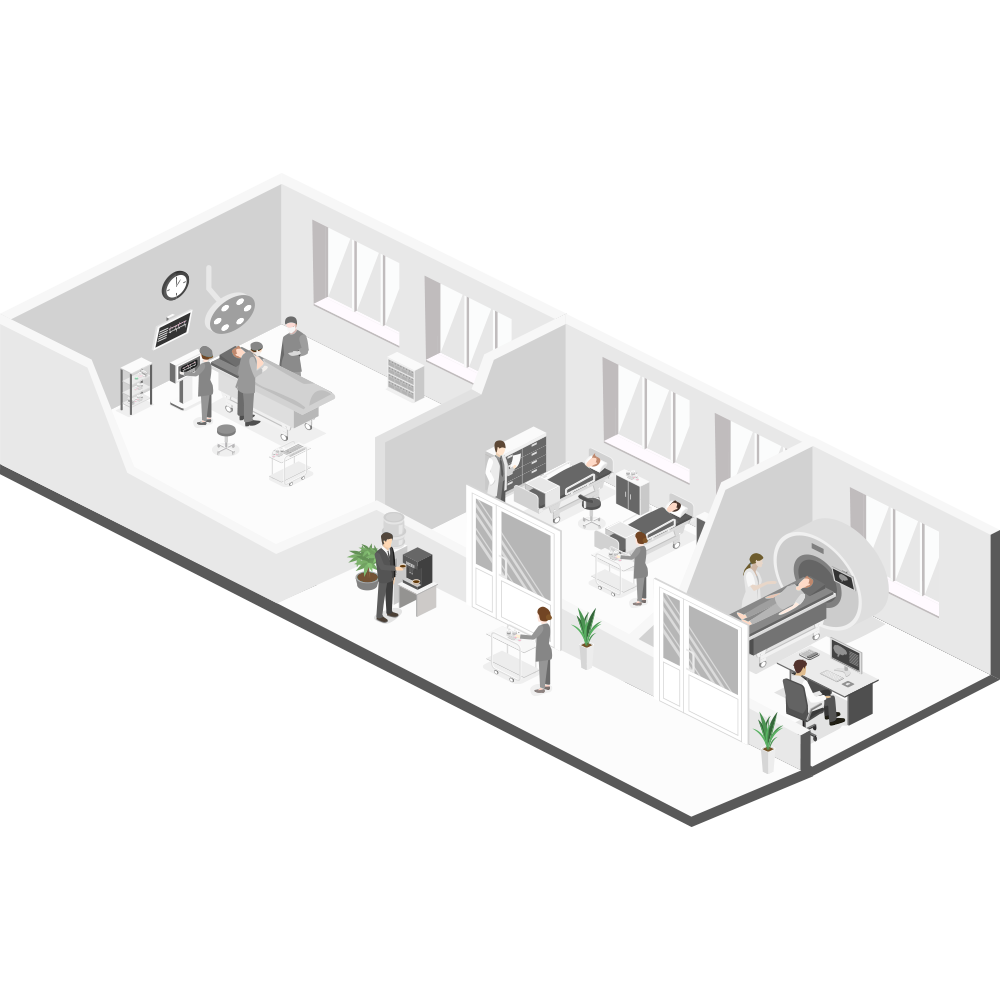The Health Insurance Portability and Accountability Act, HIPAA, protects patient privacy. Medical professionals, i.e. doctors, nurses, interns, secretaries, etc. can’t share patient’s information to anybody outside of HIPAA’s allowance. Not even their spouses! This is to protect patient’s privacy and let them control how they process and distribute information.
In busy healthcare facilities, communication is difficult to keep private. The Acoustics in Healthcare Environments CISCA report, dated October 2010, states that HIPAA requires a confidential level of speech inside healthcare facilities, which formally measures in at an articulation index level between 0.0 and 0.5.
Thankfully, you’re already in the right place. But the solution may not be as simple as propping up a bunch of absorbing panels next to a patient’s bed.
There are so many places where medical information needs to be discussed, but these discussions are likely to be overheard. Here’s a quick list of different spots where this could happen.
As a patient checks in at the front desk, others seated in the reception area may overhear snippets about the patient’s medical history. Absorbing products in the surrounding environment, preventing reverb from traveling far

Anyone passing near the nurse’s station may overhear staff discussing details from another patient’s report. Blocking products lining the walls of the desk

As people walk past rooms they can hear parts of discussions between doctors and patients or between other staff members. Absorbing products in the ceiling and blocking partitions around patient beds.

Patients waiting in line are probably going to catch the name of the prescription ordered if it’s said out loud. Absorbing products throughout the space and small blocking partitions.

In rooms with thin walls or a divider, next door’s private conversation may not be so private after all. Walls can be built or retrofitted with blocking products

Fitting 40 elementary school kids into a cramped classroom can be tricky. Getting all of them to pay attention? Nearly impossible. Every kind of noise we’ve discussed can be found in these rooms. Dealing with distractions is part of an educator’s job description, but they can only do so much when the environment they work in is actively working against them. But the interior design of a school can help teachers get the most out of their students.
When a classroom’s acoustics are poor, it causes problems with how students understand speech, behave, pay attention, and concentrate. Each of these factors can be critical to a student’s performance within their education. If a student can’t understand what the teacher is saying, they’ll be overwhelmed by the material and be less likely to ask for clarification questions on the concepts.
Don’t take our word for it, though. The American National Standard has this to say about how noise can impact a children’s learning capabilities: “Young children are more susceptible than adults to the effects of background noise and reverberation on communication with spoken language. Because of this susceptibility, young children also require more favorable classroom signal-to-noise ratios and reverberation times to achieve the same level of speech intelligibility as adults do. Developmental status, linguistics and cognitive proficiency, temporary hearing impairments, and early receptive and expressive language disorders are all factors that affect the greater susceptibility of young children to background noise and reverberation.
So noise effects healthcare and education, we’ve established that. When is it best to address the noise though? Typically, the earlier the better. When products are planned into the initial construction, you can save on labor and possibly finish materials depending on the solution. I e. Eurospan.
But hope is not lost if you’re looking at a finished space! Acoustical solutions can retrofitted just about anywhere. Whether that’s new panels added to a wall, the lining of a desk divider being upgraded with a blocking surface, or simply swapping out the tiles in the ceiling with something a bit stronger.
The Acoustical Society of America gives helpful guidelines to follow when designing schools. Following theses can help improve student performance within the classroom.
• The maximum acceptable ambient noise levels in the classroom is one-hour average A-weighted with a steady background noise level of 35 decibels
• The maximum acceptable reverberation time is 0.6 seconds. Acoustical ceiling tiles are an ideal classroom acoustics material used to soak up excess reverberation.
• Classrooms with ceiling heights less than 10 feet tall only need acoustical ceiling tiles.
• Ceiling heights 12 to 14 feet require some additional classroom acoustics material on the side walls in addition to acoustical ceiling tile.
• Ceiling heights 15 feet and over will require significant quantities of classroom acoustics treatments such as 1” fabric wrapped fiberglass wall panels or equivalent.
• All interior and exterior classroom walls must meet or exceed Sound Transmission Class Rating STC-50. Sound Transmission Class is the officially-tested sound insulation rating for a given wall, floor, ceiling, door, or window assembly.
• Partition walls between classrooms and music rooms, mechanical rooms, cafeterias, gymnasiums, indoor swimming pools, or exterior machinery must meet STC-60.1
• All classroom partitions must extend and seal to a structural ceiling rather than a false drop ceiling.
• Classroom entry-door systems must meet STC-30 with a fully sealed perimeter and threshold.
• Exterior windows must be evaluated based on existing outdoor ambient noise levels and the total glazed area.
• Carpeting on classroom floors helps control reverberation, reduce footfall noise to classrooms below, and minimize noise from moving chairs and feet.
• Classrooms must be free of discreet echoes caused by large, flat walled areas. These echoes can be eliminated through careful sound absorbing material placement like large bookshelves or furniture.

1445 Holland Rd
Maumee, OH 43537